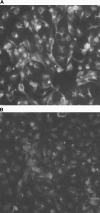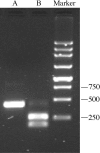Recovery of infectious rabbit hemorrhagic disease virus from rabbits after direct inoculation with in vitro-transcribed RNA
- PMID: 16775346
- PMCID: PMC1488931
- DOI: 10.1128/JVI.02078-05
Recovery of infectious rabbit hemorrhagic disease virus from rabbits after direct inoculation with in vitro-transcribed RNA
Abstract
We report the first full-length infectious clone of strain JX/CHA/97 of rabbit hemorrhagic disease virus (RHDV). The transcripts from the full-length cDNA clones were infectious when they were directly injected into rabbits. The sequence of the virus recovered from the rabbits was identical to that of the injected RNA transcripts. The cDNA clone was engineered to contain one silent nucleotide change to create an EcoRV site (A to T at nucleotide 2908). The genetic marker was retained in the recovered progeny virus. The transfection of RNA transcripts into RK-13 cells resulted in the synthesis of viral antigens, indicating that the cDNA clones were replication competent. This stable infectious molecular clone should be an important tool for developing a better understanding of the molecular biology and pathogenesis of RHDV.
Figures





Similar articles
-
Rabbit hemorrhagic disease virus poly(A) tail is not essential for the infectivity of the virus and can be restored in vivo.Arch Virol. 2008;153(5):939-44. doi: 10.1007/s00705-008-0079-9. Epub 2008 Apr 2. Arch Virol. 2008. PMID: 18385927
-
RNA transcripts derived from a cloned full-length copy of the feline calicivirus genome do not require VpG for infectivity.Virology. 1995 Jul 10;210(2):383-90. doi: 10.1006/viro.1995.1354. Virology. 1995. PMID: 7618275
-
[Rapid construction of infectious clones of infectious bursal disease virus].Sheng Wu Hua Xue Yu Sheng Wu Wu Li Xue Bao (Shanghai). 2003 Apr;35(4):338-44. Sheng Wu Hua Xue Yu Sheng Wu Wu Li Xue Bao (Shanghai). 2003. PMID: 12673387 Chinese.
-
Genetic variation and phylogenetic analysis of rabbit haemorrhagic disease virus (RHDV) strains.Acta Biochim Pol. 2012;59(4):459-65. Epub 2012 Dec 13. Acta Biochim Pol. 2012. PMID: 23240105 Review.
-
[The reverse genetics systems for human and animal RNA viruses].Sheng Wu Gong Cheng Xue Bao. 2004 May;20(3):311-8. Sheng Wu Gong Cheng Xue Bao. 2004. PMID: 15971597 Review. Chinese.
Cited by
-
Recovery of murine norovirus and feline calicivirus from plasmids encoding EMCV IRES in stable cell lines expressing T7 polymerase.J Virol Methods. 2015 Jun 1;217:1-7. doi: 10.1016/j.jviromet.2015.02.003. Epub 2015 Feb 16. J Virol Methods. 2015. PMID: 25698463 Free PMC article.
-
The outbreak of rabbit hemorrhagic virus type 2 in the interior of China may be related to imported semen.Virol Sin. 2022 Aug;37(4):623-626. doi: 10.1016/j.virs.2022.04.003. Epub 2022 May 2. Virol Sin. 2022. PMID: 35513269 Free PMC article.
-
Inclusion of an Arg-Gly-Asp receptor-recognition motif into the capsid protein of rabbit hemorrhagic disease virus enables culture of the virus in vitro.J Biol Chem. 2017 May 26;292(21):8605-8615. doi: 10.1074/jbc.M117.780924. Epub 2017 Apr 5. J Biol Chem. 2017. PMID: 28381555 Free PMC article.
-
Plasmid-based human norovirus reverse genetics system produces reporter-tagged progeny virus containing infectious genomic RNA.Proc Natl Acad Sci U S A. 2014 Sep 23;111(38):E4043-52. doi: 10.1073/pnas.1415096111. Epub 2014 Sep 5. Proc Natl Acad Sci U S A. 2014. PMID: 25192933 Free PMC article.
-
Highs and Lows in Calicivirus Reverse Genetics.Viruses. 2024 May 28;16(6):866. doi: 10.3390/v16060866. Viruses. 2024. PMID: 38932159 Free PMC article. Review.
References
-
- Collins, B. J., J. R. White, C. Lenghaus, V. Boyd, and H. A. Westbury. 1995. A competition ELISA for the detection of antibodies to rabbit haemorrhagic disease virus. Vet. Microbiol. 43:85-96. - PubMed
-
- El Mehdaoui, S., A. Touze, S. Laurent, P. Y. Sizaret, D. Rasschaert, and P. Coursaget. 2000. Gene transfer using recombinant rabbit hemorrhagic disease virus capsids with genetically modified DNA encapsidation capacity by addition of packaging sequences from the L1 or L2 protein of human papillomavirus type 16. J. Virol. 74:10332-10340. - PMC - PubMed
-
- Gould, A. R., J. A. Kattenbelt, C. Lenghaus, C. Morrissy, T. Chamberlain, B. J. Collings, and H. A. Westbury. 1997. The complete nucleotide sequence of rabbit haemorrhagic disease virus (Czech strain V351): use of the polymerase chain reaction to detect replication in Australian vertebrates and analysis of viral population sequence variation. Virus Res. 47:7-17. - PubMed
-
- Gregg, D. A., C. House, R. Meyer, and M. Berninger. 1991. Viral haemorrhagic disease of rabbits in Mexico: epidemiology and viral characterization. Rev. Sci. Tech. 10:435-451. - PubMed
Publication types
MeSH terms
Substances
LinkOut - more resources
Full Text Sources

